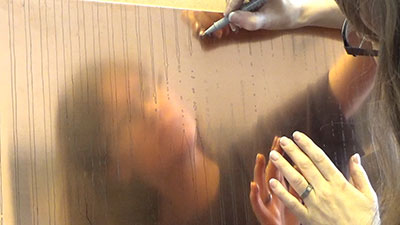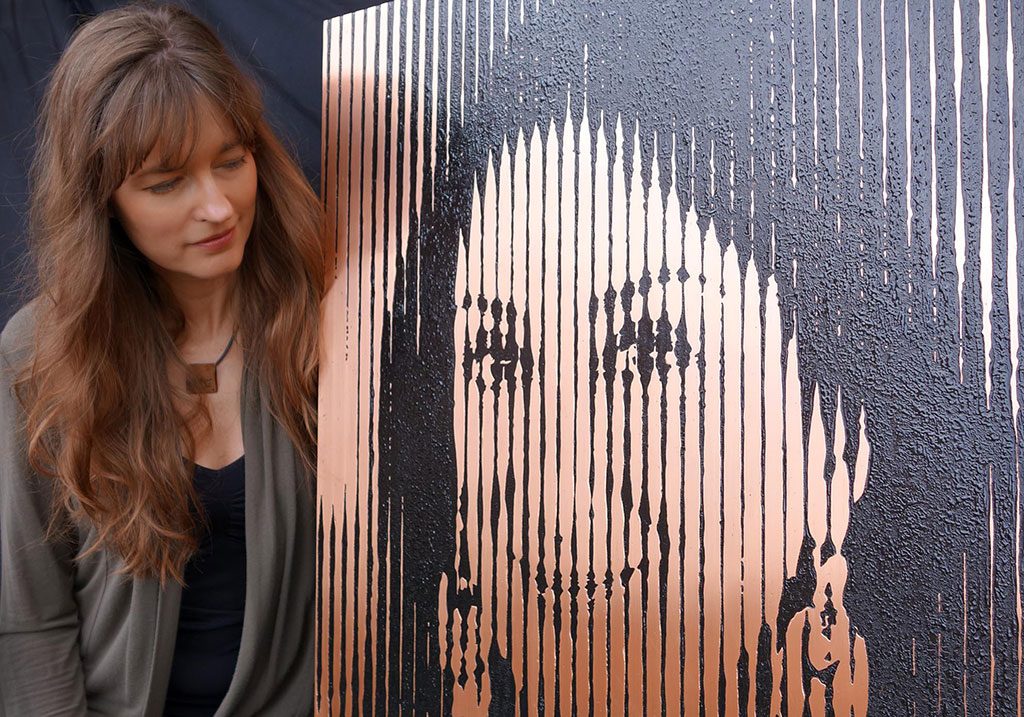
Maltese investigative journalist Daphne Caruana Galizia was assassinated on October 16, 2017, when her car was blown up. This horrendous attack on freedom of speech compelled me to act, to do whatever I could as a professional artist.
UPDATE OCTOBER 23, 9 pm:
Following the unveiling of the portrait at the European Parliament, I am overwhelmed and very grateful for the many reactions to this portrait. It means the world to me that so many of you share my feeling of outrage at the assassination of Daphne Caruana Galizia. This page is being continuously updated with press coverage of the unveiling and other developments. Below are two photos from the unveiling ceremony with Matthew Caruana Galizia, President Antonio Tajani and Peter Caruana Galizia.
Films, photos and downloads:
• Click here to download the complete press kit (from Dropbox). It contains edited films (the two referred to immediately below, at a higher resolution) showing the creation of the portrait, high resolution photos and my speech for the unveiling. • Click here to watch a the short, three minute video which shows how the portrait was created.  • Click here to watch the complete eight minute video, showing both the creation of the portrait and a subtitled interview (in English) with me about its background and the techniques used.
• Click here to watch the complete eight minute video, showing both the creation of the portrait and a subtitled interview (in English) with me about its background and the techniques used.
Publications:
Press coverage about this portrait has been extensive and can be found on this page.
Context and background:
I have lived and worked in Malta about four months a year since 2011 and I was very familiar with Daphne Caruana Galizia’s work long before her assassination. Daphne was Malta’s most prominent investigative journalist and was described as a “one-woman WikiLeaks” by Politico in December 2016. Her assassination rattled the island. But in Malta both the context and the aftermath are vehemently divisive and political. If you are interested in knowing more about the situation in Malta, I recommend these very well-written articles:• Forbidden Stories is a platform that works to protect threatened investigative journalists. They have organized The Daphne Project, which is a consortium of 45 investigative reporters from 18 news organizations in 15 countries, working to complete Daphne Caruana Galizia’s work. This page gives a bit of background to how they work and links to the stories that form The Daphne Project.• A three minute film by Forbidden Stories: “Daphne’s murder: the investigation so far”• A month after the assassination of Daphne Caruana Galizia, the press conference room of the European Parliament in Strasbourg was named after Daphne Caruana Galizia. The Malta Independent wrote about the inauguration. This article includes filmed speeches by European Parliament President Antonio Tajani and Daphne’s husband Peter.• Politico described Daphne Caruana Galizia as a “one-woman WikiLeaks” when, ten months before her assassination, they chose her as one of the 28 people in Europe who were shaping the world in 2017 and beyond.• A short, piercing article by Reuters: “The Silencing of Daphne”• An in-depth article in The Economist: “Murder in Malta”• The European Centre for Press and Media Freedom, ECPMF, has published this disturbing and stark article by Iris Rohmann, winner of the German Reporter Forum’s Daphne Caruana Galizia grant. She has looked into the circumstances of the Daphne Caruana Galizia murder.• A short article on the NPR website. There is also a six minute audio clip which includes a short comment by Daphne Caruana Galizia’s Pulitzer-winning son Matthew, as well as Daphne herself. • Margaret Atwood has written brilliantly on behalf of PEN International in The Guardian about the situation twelve months on. • European Parliament President Antonio Tajani wrote in The Times of Malta on the first anniversary of Daphne Caruana Galizia’s assassination. President Tajani, himself a journalist, said that “in standing for Daphne, you should know that you have the full force of the voice of 500 million European citizens with you”.
Thank you
So many people have helped in different, invaluable ways with this project and I am immensely grateful to them all. Dr Peter Agius put his heart and soul into removing all obstacles, bureaucratic and otherwise, helping make it possible. Professor George Attard was, as ever, very generous with crucial advice. Thanks are also due to European President Antonio Tajani for endorsing this project in such a heartfelt way. And without the full support of Daphne’s family, there would have been no portrait.



















